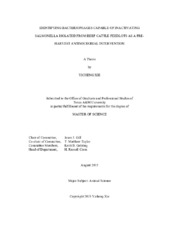| dc.description.abstract | Asymptomatic Salmonella carriage in beef cattle is a significant food safety concern and the beef feedlot environment is a reservoir of this pathogen. The goal of this study was to identify and isolate bacteriophages against Salmonella from beef cattle feedlots. Three feedlots in south Texas previously characterized for Salmonella enterica prevalence were visited and samples (n=108) collected from dropped feces, feed, drinking water, and soil in cattle pens. Pre-enrichment, selective enrichment and selective/differential isolation of Salmonella were performed on each sample. A representative subset of presumptive Salmonella isolates was prepared for biochemical identification and serotyping. Samples were pooled by site to create 36 samples and enriched to recover phage. Recovered phages were tested for host range against a diverse panel of 20 Salmonella strains representing 12 serotypes. Salmonella were identified in 20 of 108 samples (18.5%) by biochemical and/or serological testing. Comparative testing between biochemical and molecular methods yielded only one disagreement, where molecular detection failed to confirm Salmonella presence from pre-enrichment medium. Serovars including S. Anatum, Muenchen, Altona, Kralingen, Kentucky and Montevideo were identified in the samples; S. Anatum was the most frequently recovered serotype of Salmonella. Phage-positive samples were distributed evenly over the three sampled feedlot sites, suggesting that phage prevalence is not strongly correlated with the presence of culturable Salmonella. Phages were found more frequently in soil and feces compared to feed and water samples. Host ranges of the phages were highly variable, with the broadest host range phage infecting 16 of the 20 Salmonella strains tested. Bacteriophages found in the Salmonella-free feedlot suggest that phages might play a role in suppressing the Salmonella population in a feedlot environment. This may also indicate that endogenous phages may contribute to false-negative results in culture-based Salmonella detection. Some phages were able to infect a broad range of Salmonella serovars, giving them possible utility as an intervention against Salmonella in feedlots. | en |


